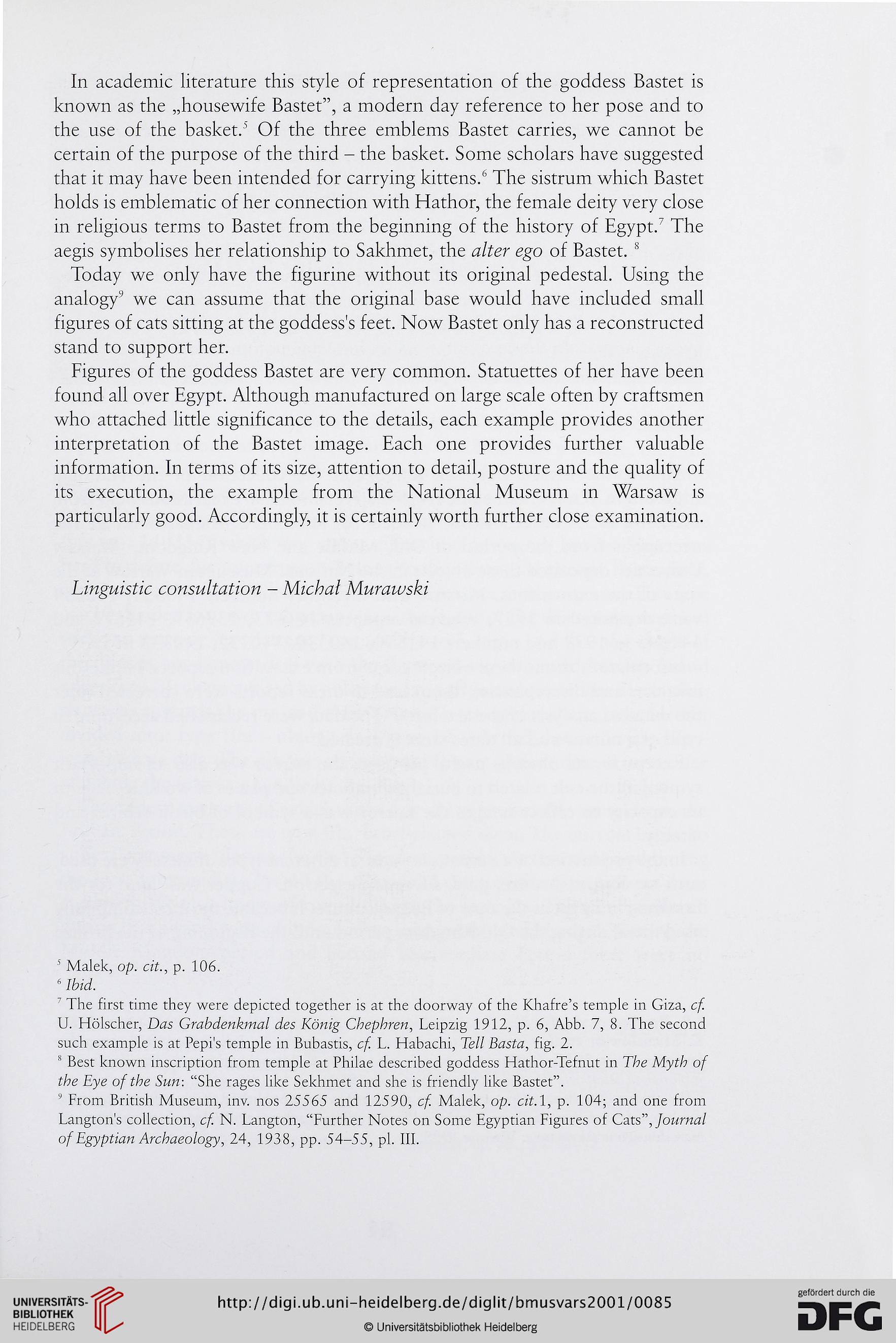In academic literaturę this style of representation of the goddess Bastet is
known as the „housewife Bastet”, a modern day reference to her pose and to
the use of the basket.5 Of the three emblems Bastet carries, we cannot be
certain of the purpose of the third - the basket. Some scholars have suggested
that it may have been intended for carrying kittens.6 * The sistrum which Bastet
holds is emblematic of her connection with Hathor, the female deity very close
in religious terms to Bastet from the beginning of the history of Egypt. The
aegis symbolises her relationship to Sakhmet, the alter ego of Bastet. 8
Today we only have the figurine without its original pedestal. Using the
analogy9 we can assume that the original base would have included smali
figures of cats sitting at the goddess's feet. Now Bastet only has a reconstructed
stand to support her.
Figures of the goddess Bastet are very common. Statuettes of her have been
found all over Egypt. Although manufactured on large scalę often by craftsmen
who attached little significance to the details, each example provides another
interpretation of the Bastet image. Each one provides further valuable
information. In terms of its size, attention to detail, posturę and the ąuality of
its execution, the example from the National Museum in Warsaw is
particularly good. Accordingly, it is certainly worth further close examination.
Linguistic consultation - Michał Murawski
5 Małek, op. cit., p. 106.
6 Ibid.
The first time they were depicted together is at the doorway of the Khafre’s tempie in Giza, cf
U. Holscher, Das Grabdenkmal des Kónig Chephren, Leipzig 1912, p. 6, Abb. 7, 8. The second
such example is at Pepi's tempie in Bubastis, cf L. Habachi, Tell Basta, fig. 2.
s Best known inscription from tempie at Philae described goddess Hathor-Tefnut in The Myth of
the Eye of the Sun-. “She rages like Sekhmet and she is friendly like Bastet”.
9 From British Museum, inv. nos 25565 and 12590, cf Małek, op. cit. 1, p. 104; and one from
Langton's collection, cf. N. Langton, “Further Notes on Some Egyptian Figures of Cats”, Journal
of Egyptian Archaeology, 24, 1938, pp. 54-55, pl. III.
known as the „housewife Bastet”, a modern day reference to her pose and to
the use of the basket.5 Of the three emblems Bastet carries, we cannot be
certain of the purpose of the third - the basket. Some scholars have suggested
that it may have been intended for carrying kittens.6 * The sistrum which Bastet
holds is emblematic of her connection with Hathor, the female deity very close
in religious terms to Bastet from the beginning of the history of Egypt. The
aegis symbolises her relationship to Sakhmet, the alter ego of Bastet. 8
Today we only have the figurine without its original pedestal. Using the
analogy9 we can assume that the original base would have included smali
figures of cats sitting at the goddess's feet. Now Bastet only has a reconstructed
stand to support her.
Figures of the goddess Bastet are very common. Statuettes of her have been
found all over Egypt. Although manufactured on large scalę often by craftsmen
who attached little significance to the details, each example provides another
interpretation of the Bastet image. Each one provides further valuable
information. In terms of its size, attention to detail, posturę and the ąuality of
its execution, the example from the National Museum in Warsaw is
particularly good. Accordingly, it is certainly worth further close examination.
Linguistic consultation - Michał Murawski
5 Małek, op. cit., p. 106.
6 Ibid.
The first time they were depicted together is at the doorway of the Khafre’s tempie in Giza, cf
U. Holscher, Das Grabdenkmal des Kónig Chephren, Leipzig 1912, p. 6, Abb. 7, 8. The second
such example is at Pepi's tempie in Bubastis, cf L. Habachi, Tell Basta, fig. 2.
s Best known inscription from tempie at Philae described goddess Hathor-Tefnut in The Myth of
the Eye of the Sun-. “She rages like Sekhmet and she is friendly like Bastet”.
9 From British Museum, inv. nos 25565 and 12590, cf Małek, op. cit. 1, p. 104; and one from
Langton's collection, cf. N. Langton, “Further Notes on Some Egyptian Figures of Cats”, Journal
of Egyptian Archaeology, 24, 1938, pp. 54-55, pl. III.




